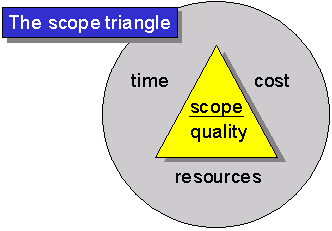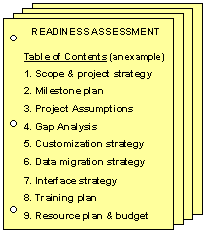
ERP Readiness Assessment
Ed White
Origin Technology in Business
10 Carlson Court, Suite 800
Toronto Ontario
M9V 6L2
Phone: 416 7981110 ext. 4204
Fax: 416 7980222
E-mail: ed.white@ca.origin-it.com
Contents
- Assessment Positioning
- Related Areas
- The Assessment
- Benefits of the Assessment
1. Assessment Positioning
Gartner quote:
"The deployment of large-scale integrated
software packages fail at a rate of 50 percent. Failure is defined as inoperable,
undeliverable, or the deployment has gone over budget or time by more than 30 percent. *
* Failure Management: Get it Right the Third Time,
Gartner Group Research Note July 25, 1996
KPMG study*:
Three main reasons for failed IT projects:
- Lousy planning, including risk management and a weak project plan
- An inadequate business case that fails to explain how the IT project relates to the
organization’s needs
- Lack of top management involvement and support
* - Toronto GLOBE AND MAIL, April 15, 1998
At the start of a customer’s implementation Origin has been asked:
"Will it work?"
"Have we satisfactorily completed all the deliverables from the selection
process?"
"We’ve selected Baan as the software vendor and now we need assistance to
define the next steps."
A Readiness Assessment is NOT -
- a project audit
- a feasibility study
- a "service" offering for -
- technical infrastructure
- interface/component architecture
- implementation review or audit
- a business process study or verification
BUT Origin has been asked for some of these to be included in the Assessment Report
The starting point can be one of -
- Software selected -
looking for an implementation partner
- Software not selected -
need for selection verification
looking for an implementation partner
- System operating -
technical / functional upgrade
- Implementation started -
looking for a new implementation partner
The Assessment should -
- create a bridge between the customer needs and the implementation of their ERP
system
- define the starting point for key components of the implementation -
e.g. risk assessment is input to the possible use of risk management
- specify realistic expectations of the successful implementation, for management
2. Related Areas
2.1 Software Selection Process
Software Selection Phase, typical milestones
- Feasibility determined
- (Generic) solution agreed
- Business solution assessed
- Technical solution assessed
- Program plan agreed
- Final Proposal Presented
- Partnership agreed (software)
Typical activities during milestone # 5, Program Plan Agreed
- Perform project readiness assessment
- Define responsibilities of client, software vendor and partner
- Build a global implementation team
- Choose implementation scenario
- Define objective/scope/team/responsibility for each site/phase
- Define communication & documentation structure for each site/phase
- Define resources for each site/phase
- Analyze risks for each sit/phase
- Define support structure during & after implementation
- Discuss Competence Center concept
- Draw up rough cut program plan
- Obtain approval for rough cut program plan
During the software sales cycle, have these activities been performed?
How well have they been performed?
What expectations have been set? at the user level? at the management level?
The Readiness Assessment provides a "time out" for completeness.
Typical deliverables during milestone # 5, Program Plan Agreed
- Feasibility report
- Budget proposal
- Management demo
- Business solution report
- Technology solution report
- Program / project budget
- Final proposal
- Letter of intent
- Evaluation report
- Contract
Are these deliverables available?
What is their quality?
Have the deliverables created other expectations? at the user level? at the management
level?
The Readiness Assessment provides a "time out" for quality.
2.2 Program and Project Management

The implementation’s scope, resources, time, quality and cost are carefully
analyzed during the assessment.
2.3 Implementation Management Components
- Contract Management
- Risk Management
- Program/project management including change control and issue management
- Quality management
- Change management
- Tool management
Each of these implementation management components are applicable within an
implementation. The degree of their application will vary by project. The Assessment will
provide individual visibility of each.
3. The Assessment
May begin with a Proposal to perform the assessment. It will contain:
- Origin’s schedule, resources , scope and cost.
- A sample deliverable
- Customer’s role & responsibility
resources, schedule and documentation
- Definition of the first steps
The deliverable:
- a proposal for resources, skills, processes and services to support the customer’s
implementation of the ERP system
- will be different for each customer
- is tailored to the customer’s needs
- is developed using Origin templates that help to guide the assessment process
Assessment Content:
- Project organization
- Project plan
- High level functional gap analysis
- Data migration requirements
- Interface requirements
- Data profile
- Project history
- Infrastructure
- Risk assessment
- Implementation measures of success
- Cost estimates

The general contents of each section of the Readiness Assessment are as follows:
- Project Organization
- Roles and responsibilities
- Project structure
- Program/project control
- Project Plan
- Scope
- Expectations
- Preliminary milestone plan
- Resource plan
- Assumptions
- High level functional gap analysis
- Reference model
- Issues
- Reports
- Budget estimate for customizations
- Data migration requirements
- What data? Master, historical, point-in-time
- Budge estimate for automated conversion
- Interface requirements
- Interfaces to and from
- Budget estimate for interfaces
- Data profile
- Transactions and master data
- Backup/recovery
- Project history
- Customer strengths
- Skills assessment
- Project expectations
- Infrastructure
- Hardware
- Network
- Database
- Software
- Risk Assessment
- Implementation measures of success
- Cost Estimate
- Area of cost; time, material, expenses
4. Benefits of the Assessment
We need to avoid what Edward Yourdon calls the "Death March" project*:
"I define a death march project as one whose "project parameters exceed the
norm by at least 50 percent." For example:
The schedule has been compressed to less than half the amount of time estimated by a
rational estimating process.
- The same type of constraint may be imposed on staff, budget, functionality, features, or
performance.
The Readiness Assessment -
Provides the opportunity to know your implementation partner
Gets the implementation started on the right foot
Assurance that the implementation has:
- an approval process
- a reasonable but realistic budget
- user and management support
Author | Title | Tracks | Home



